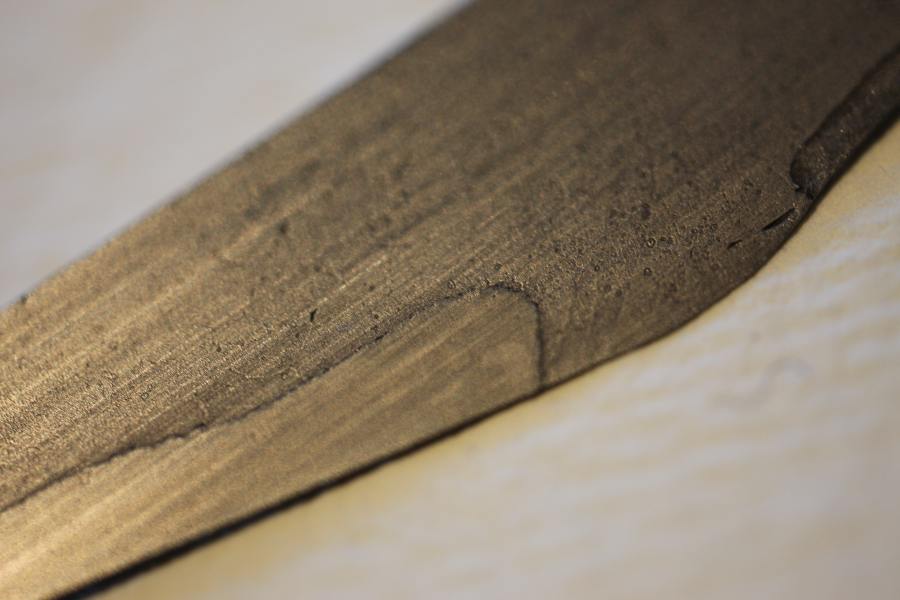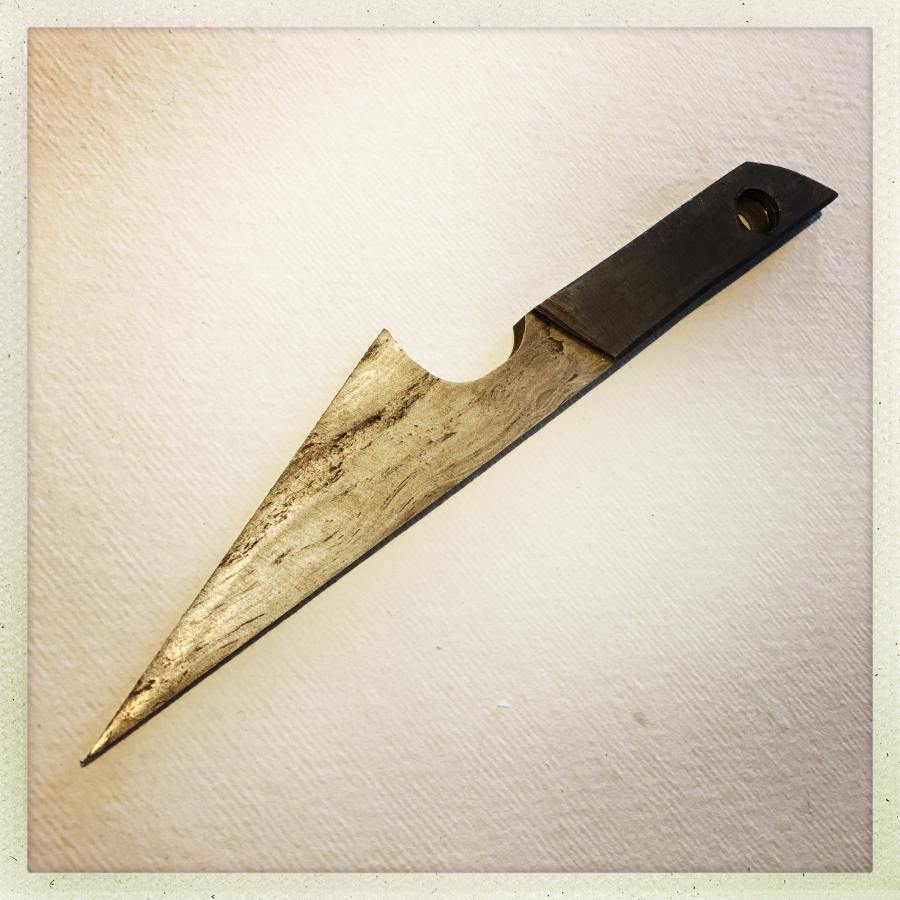Some closeups of metal using a Canon MP-E 65mm macro lens. The depth of field of the lens is very shallow, and it’s a pain to hand-hold.
When I first got the lens, my master plan was to use it to do high-contrast black-and-white images of bugs, which I was then going to print out on film, and make contact wet-plate prints on glass. The whole process worked but it turned out that highly enlarged wet-plates of bugs just weren’t very interesting to me. I had a momentary thrill when I discovered that I could contact-print a wet-plate (using a halogen bulb in my medium format enlarger!) but the process was a great big nasty amount of work – and who really wants a digital-to-wet-plate?

Closeup of wire rope damascus. You can see the outlines of the wires in the bar, but they are thoroughly welded. I guess that the coloration between the formerly separate pieces must be carbon.
That piece was etched in ferric chloride for about an hour, so its surface is not just the 1000-grit polish I did on it – but since the abrasion-lines are still there I guess it didn’t etch away a lot of material.

Transition between wire rope damascus and 1095 bar.

Wrought iron. The iron was polished and etched mildly.
Vintage wrought iron (“puddle iron”) like this has these ropy tendrils running through it in a very clear grain. I do not understand why/how that grain forms; it’s got to be similar to the dendritic formations in wootz/crucible steel but clearly it’s not the same at all.
Before I got started doing this stuff, I thought steel was pretty simple. It’s just metal. You take a couple bars and mash them together with some heat. Then you push that into the shape of a knife and dunk it in water. Ha, ha, ha, stupid Marcus.
The wrought iron piece is a closeup of an experiment that’s on my bench right now, a 2-layer (“ni mai”) piece of 1095 with a wrought iron facing. I have great hopes for this combination because it combines the aesthetic I want with the edge performance I need. I believe that this will make some strong, interesting-looking, wickedly sharp cooking knives. But I didn’t jump straight to trying to forge that sort of thing; I’m doing these little tests, first. It would be crushing if I spent a day shaping a cooking knife blade and it blows apart when I try to quench it.

That’s a pretty small chunk of a larger bar, which I sectioned for testing. I squished down two pieces and made a pair of those things above. The first one I did by hammer-forging and cutting with a grinding wheel and grinders, the second one I did using the milling machine. It turns out that milling machines are great for machining stuff! Who’d’a thunk it!? The one above took about an hour to cut, profile, and grind to that shape. The one I did on the milling machine took 10 minutes and came out with a beautiful polish from the face mill, and absolutely parallel edges on the handle-oid part.
When I get home from LA they’re going into the fire for a quench and then I’ll finish grinding that bevel. Wrought iron is dreamy to grind and it won’t harden when I quench it. The question is whether the 1095 will harden with that great big thermal mass attached to it, or if it’ll warp or blow apart or what.
(This is just a test so I want the stress-points to be there. If it’s going to blow up, I want it to blow up before I start trying to make anything real using this combination)

That last one looks like a piece of weathered sea polished wood. Gorgeous.
Bearing in mind that all I know about steel is what I learnt in Social and Economic History O Level forty plus years ago, IIRC wrought iron is hammered out and folded repeatedly during production to reduce … memory fails at this point, but the process is to make the iron less brittle than pig iron it is made from. Anyway could the ropey tendrils be related to that process?
jazzlet@#1:
IIRC wrought iron is hammered out and folded repeatedly during production to reduce … memory fails at this point, but the process is to make the iron less brittle than pig iron it is made from. Anyway could the ropey tendrils be related to that process?
I believe you’re right – the “wrought” part of “wrought iron” is the hammering of puddle/pig iron to alter its grain structure and, I believe, more evenly distribute any alloys in the metal. Pig iron or cast iron are crumbly and hard to work under a hammer; knife-makers generally don’t use them, unless they’re reproducing a steel-making cycle.
My knowledge about wrought iron is pretty minimal (other than that it’s tough, beautiful, and has cool grain structure) – knife-makers don’t use it much, and I haven’t stumbled across references about it. I haven’t looked very hard. Some sword-makers build furnishings out of wrought iron (Howard Clark) – sword-guards and things like that. I’ve seen wrought iron inlayed into steel blades (!) in reproduction “ulfbehrt” swords. It’s not like steel to work, at all – you need to work it at yellow heat or it can crumble. So, I did this piece all at welding temperature and then machined it down. Basically, I am dealing with the two pieces of metal as though they’re just something attached to eachother – I will try to harden and temper the 1095 and let the wrought iron fend for itself, and see what happens to it.
Wikipedia says:
The “slag” is basically glass and carbides – apparently wrought iron holds up to weather much better than pure iron or mild steel. It turns out that the Eiffel Tower is a great big supply of knife-making material that the French are selfishly hoarding.
I love the way the wrought iron is silky smooth but rough-looking and when you touch it, it’s flat but it looks like it should be textured.
Oh, I love the design of that knife, it’s fabulous!
Caine@#3:
Oh, I love the design of that knife, it’s fabulous!
I am hoping it will get even better once it’s ground down and the black edge of the 1095 is visible along the bevel. That one is a prototype. The real version is intended to have ebony/bone-pinned slabs on the handle-oid. And it’s probably going to be stretched out longer.
One problem I have discovered is that wrought iron, while “soft”, is not exactly soft. Making that lanyard-hole consumed a carbide drill bit. I’m sure a 1/4″ end-mill on the bridgeport will do the job but… dang, that stuff is stubborn. Which is why I like it!
That’s cool. I finally got my Damascus letter opener. I’ve given up the photoing thing because well … Anyway, I’ll try to get you a few photos. Somehow.
Are you planning for an exactly straight edge in the working models? I like a bit a shallow curve in my kitchen knives.
Raucous Indignation@#6:
The blade geometry on that thing is definitely not good for a cooking knife. You’re correct that a bit of a curve is better. I’m one of the “hollow grind on one side, chisel grind on the other” types but that’s a matter of taste. These test pieces are to see whether 1095 and wrought iron can survive a quench/temper process and not come apart or turn into a steel pringles chip (I figured since I’m making them I may as well make them so that they’ll be worth having if they turn out) Actual working knives would be 8-10″ blade with a long narrow curve.
If you email me a picture of your letter opener, I can post it here if you want.
I’m going to try photoing the letter opener today. Please be kind.